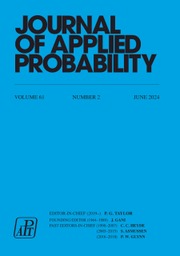Article contents
Asymptotic expansion of the invariant measure for Markov-modulated ODEs at high frequency
Published online by Cambridge University Press: 30 January 2025
Abstract
We consider time-inhomogeneous ordinary differential equations (ODEs) whose parameters are governed by an underlying ergodic Markov process. When this underlying process is accelerated by a factor  $\varepsilon^{-1}$, an averaging phenomenon occurs and the solution of the ODE converges to a deterministic ODE as
$\varepsilon^{-1}$, an averaging phenomenon occurs and the solution of the ODE converges to a deterministic ODE as  $\varepsilon$ vanishes. We are interested in cases where this averaged flow is globally attracted to a point. In that case, the equilibrium distribution of the solution of the ODE converges to a Dirac mass at this point. We prove an asymptotic expansion in terms of
$\varepsilon$ vanishes. We are interested in cases where this averaged flow is globally attracted to a point. In that case, the equilibrium distribution of the solution of the ODE converges to a Dirac mass at this point. We prove an asymptotic expansion in terms of  $\varepsilon$ for this convergence, with a somewhat explicit formula for the first-order term. The results are applied in three contexts: linear Markov-modulated ODEs, randomized splitting schemes, and Lotka–Volterra models in a random environment. In particular, as a corollary, we prove the existence of two matrices whose convex combinations are all stable but are such that, for a suitable jump rate, the top Lyapunov exponent of a Markov-modulated linear ODE switching between these two matrices is positive.
$\varepsilon$ for this convergence, with a somewhat explicit formula for the first-order term. The results are applied in three contexts: linear Markov-modulated ODEs, randomized splitting schemes, and Lotka–Volterra models in a random environment. In particular, as a corollary, we prove the existence of two matrices whose convex combinations are all stable but are such that, for a suitable jump rate, the top Lyapunov exponent of a Markov-modulated linear ODE switching between these two matrices is positive.
Information
- Type
- Original Article
- Information
- Copyright
- © The Author(s), 2025. Published by Cambridge University Press on behalf of Applied Probability Trust
References
- 1
- Cited by


